Polokwane
Polokwane (UK: /ˌpɒləˈkwɑːnɪ/[3], meaning "Place of Safety" in Northern Sotho[4][5][6]), also known by its former name, Pietersburg, is a city and the capital of the Limpopo Province of South Africa. It is South Africa's largest urban centre north of Gauteng. Polokwane was one of the host cities of the official tournament of the 2010 FIFA World Cup.
Polokwane Pietersburg | |
|---|---|
 Polokwane's City Centre | |
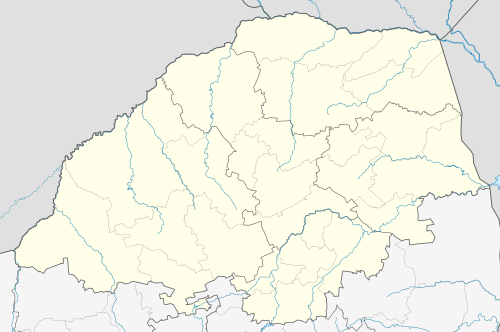 Polokwane 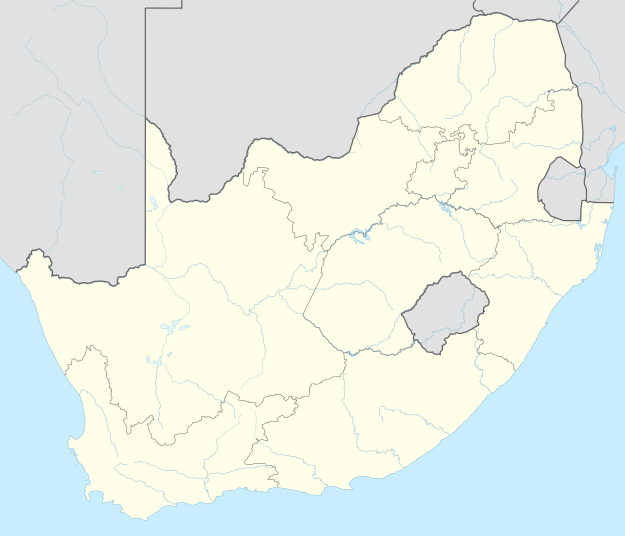 Polokwane 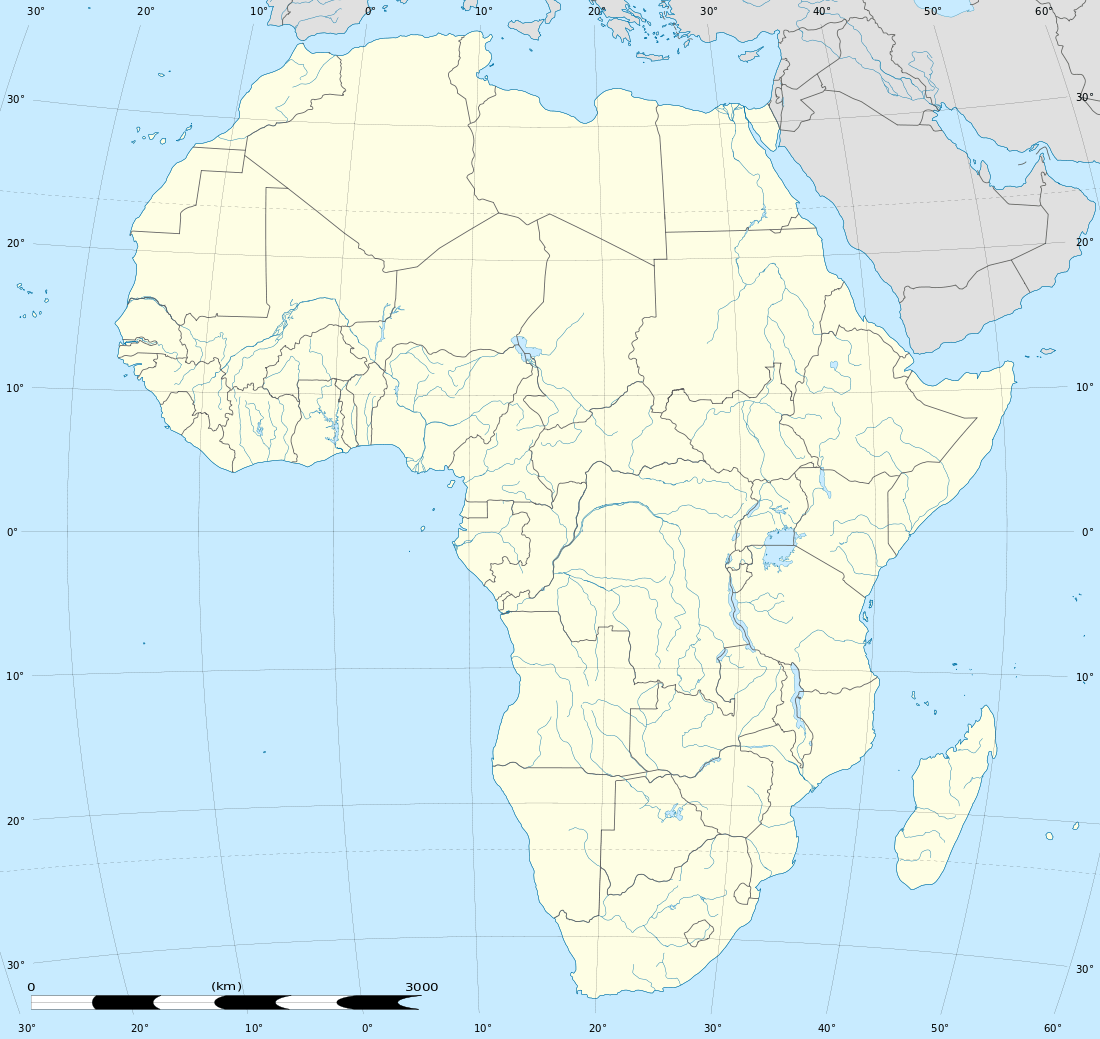 Polokwane | |
| Coordinates: 23°54′00″S 29°27′00″E | |
| Country | |
| Province | Limpopo |
| District | Capricorn |
| Municipality | Polokwane |
| Established | 1886 |
| Government | |
| • Executive Mayor | Thembi Nkadimeng[1] (ANC) |
| Area | |
| • Total | 106.84 km2 (41.25 sq mi) |
| Elevation | 1,310 m (4,300 ft) |
| Population (2011)[2] | |
| • Total | 130,028 |
| • Density | 1,200/km2 (3,200/sq mi) |
| Racial makeup (2011) | |
| • Black African | 74.4% |
| • Coloured | 3.7% |
| • Indian/Asian | 3.1% |
| • White | 18.2% |
| • Other | 0.5% |
| First languages (2011) | |
| • Northern Sotho | 45.9% |
| • Afrikaans | 19.8% |
| • English | 10.3% |
| • Venda | 6.7% |
| • Other | 17.3% |
| Time zone | UTC+2 (SAST) |
| Postal code (street) | 0699 |
| PO box | 0700 |
| Area code | 015 |
| Bird | Northern royal albatross |
| Flower | Blue squill |
| Website | www |
History
In the 1840s, Voortrekkers under the leadership of Andries Potgieter established Zoutpansbergdorp, a town 100 km (62 mi) to the northwest. This settlement had to be abandoned because of clashes with the local tribes. They founded a new town in 1886 and named it "Pietersburg" in honour of Voortrekker leader Petrus Jacobus Joubert. The British built a concentration camp at Pietersburg during the Boer War to incarcerate almost 4,000 Boer women and children. The town officially became a city on 23 April 1992; on 25 February 2005, the government declared the official name of the city as Polokwane, a name that was generally in use by the speakers of Northern Sotho. The city was host to 52nd national conference of the African National Congress, held in December 2007 and saw Jacob Zuma voted as President of the ANC.[7][8]
Demographics
In 1904, Pietersburg had a population of 3,276, of whom 1,620 (49.5%) were whites.[9] Pietersburg was a white-designated area during apartheid, so had an overwhelming white majority before 1990. After the dismantling of apartheid, the city still retained a large white population. Neighbouring townships have black majorities.[10]
The South African census showed the population of Polokwane City as 130,028 with 43,846 households in the 2011 census.
| Group | Percentage[11] |
|---|---|
| Black African | 74,4% |
| Coloured | 3,7% |
| Indian/Asian | 3,1% |
| White | 18,2% |
| Other | 0,6% |
Districts/suburbs/townships
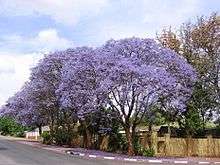
Popular suburbs in the city include Westenburg, Nirvana, Bendor, Welgelegen, Moregloed, Annadale, Ivydale, Flora Park, Fauna Park, Penina Park, Ivy Park, Hospital Park, Ster Park, Dalmada, Broadlands, Woodlands, Southern Gateway and Thornhill.[12]
Besides the above-mentioned suburbs in the city, three clusters of suburbs around the city exist:[13]
- The Seshego cluster - on the north-west outskirts of the city
- Molepo/Maja/Chuene cluster - 20 km south of the city centre
- Mankweng/Sebayeng/Dikgale cluster - 30 km east of the city centre
Climate
| Polokwane | ||||||||||||||||||||||||||||||||||||||||||||||||||||||||||||
|---|---|---|---|---|---|---|---|---|---|---|---|---|---|---|---|---|---|---|---|---|---|---|---|---|---|---|---|---|---|---|---|---|---|---|---|---|---|---|---|---|---|---|---|---|---|---|---|---|---|---|---|---|---|---|---|---|---|---|---|---|
| Climate chart (explanation) | ||||||||||||||||||||||||||||||||||||||||||||||||||||||||||||
| ||||||||||||||||||||||||||||||||||||||||||||||||||||||||||||
| ||||||||||||||||||||||||||||||||||||||||||||||||||||||||||||
Polokwane features a semiarid climate under the Köppen climate classification. Despite its position on the Tropic of Capricorn,[15] the climate is tempered by its position on a plateau 1230 m above sea level.[16] Average temperatures reach around 21–22 °C (70–72 °F) in January and fall to 11 °C (52 °F) in July.[16] As with much of inland South Africa, Polokwane has experienced notably warmer seasons over the last decade than its long-term average.[17] Polokwane has a dry climate with a summer rainy season and a pronounced dry spell during winter. Average annual rainfall is 495 mm (19.5 in), with December or (less often) January the wettest month and July the driest.[18]
| Climate data for Polokwane (1961−1990, extremes 1953–present) | |||||||||||||
|---|---|---|---|---|---|---|---|---|---|---|---|---|---|
| Month | Jan | Feb | Mar | Apr | May | Jun | Jul | Aug | Sep | Oct | Nov | Dec | Year |
| Record high °C (°F) | 37.1 (98.8) |
38.4 (101.1) |
34.5 (94.1) |
33.9 (93.0) |
32.8 (91.0) |
28.6 (83.5) |
27.8 (82.0) |
32.0 (89.6) |
36.8 (98.2) |
37.0 (98.6) |
37.4 (99.3) |
36.8 (98.2) |
38.4 (101.1) |
| Average high °C (°F) | 28.1 (82.6) |
27.6 (81.7) |
26.6 (79.9) |
24.4 (75.9) |
22.4 (72.3) |
19.6 (67.3) |
19.9 (67.8) |
22.1 (71.8) |
25.2 (77.4) |
26.1 (79.0) |
26.5 (79.7) |
27.4 (81.3) |
24.7 (76.5) |
| Daily mean °C (°F) | 22.0 (71.6) |
21.3 (70.3) |
20.7 (69.3) |
17.8 (64.0) |
14.7 (58.5) |
11.7 (53.1) |
11.8 (53.2) |
14.1 (57.4) |
17.5 (63.5) |
19.3 (66.7) |
20.3 (68.5) |
21.3 (70.3) |
17.7 (63.9) |
| Average low °C (°F) | 17.1 (62.8) |
16.7 (62.1) |
15.3 (59.5) |
12.2 (54.0) |
7.9 (46.2) |
4.7 (40.5) |
4.4 (39.9) |
6.7 (44.1) |
10.4 (50.7) |
13.3 (55.9) |
15.2 (59.4) |
16.4 (61.5) |
11.7 (53.1) |
| Record low °C (°F) | 9.8 (49.6) |
10.6 (51.1) |
7.9 (46.2) |
3.6 (38.5) |
0.2 (32.4) |
−3.5 (25.7) |
−3.2 (26.2) |
−2.4 (27.7) |
0.2 (32.4) |
5.0 (41.0) |
6.9 (44.4) |
8.8 (47.8) |
−3.5 (25.7) |
| Average precipitation mm (inches) | 82 (3.2) |
60 (2.4) |
52 (2.0) |
33 (1.3) |
11 (0.4) |
5 (0.2) |
3 (0.1) |
6 (0.2) |
17 (0.7) |
43 (1.7) |
85 (3.3) |
81 (3.2) |
478 (18.8) |
| Average precipitation days (≥ 1.0 mm) | 7 | 6 | 5 | 4 | 2 | 1 | 0 | 1 | 1 | 5 | 8 | 7 | 47 |
| Average relative humidity (%) | 69 | 70 | 71 | 69 | 64 | 61 | 58 | 56 | 55 | 61 | 66 | 69 | 64 |
| Mean monthly sunshine hours | 253.2 | 220.8 | 241.4 | 232.0 | 271.0 | 261.1 | 279.1 | 281.3 | 276.6 | 264.7 | 235.3 | 254.0 | 3,070.5 |
| Source 1: NOAA (normals and June record low only),[19] Meteo Climat (record highs and lows)[20] | |||||||||||||
| Source 2: South African Weather Service[14] | |||||||||||||
Transport
Air
Polokwane is served by two airports. A public airport, Polokwane International Airport, (IATA: PTG, ICAO: FAPP),[21] is just north of the city, while the smaller Pietersburg Civil Airport (IATA: PTG, ICAO: FAPI) is south-east of the city.[22]
Roads
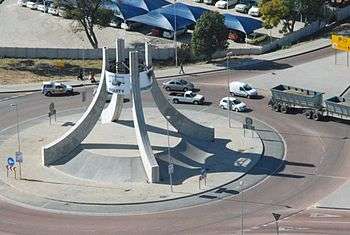
Polokwane lies roughly halfway between Gauteng (300 kilometres (190 mi)) and the Zimbabwean border (200 kilometres (120 mi)) on the N1 highway, which connects Zimbabwe with the major cities of South Africa, such as Pretoria, Johannesburg, Bloemfontein, and Cape Town.
The R37 provincial route connects the city with Nelspruit. Running east, the R71 connects the city with Tzaneen, Phalaborwa, Bushbuckridge, and the Kruger National Park. To north-east, is the R81 connecting the city with Giyani and Malamulele. The R521 connects the city with Alldays and the R567 via Seshego connects Polokwane with the N11. The R71 is also well known to bikers who ride through the city annually, making it the biggest bike meeting in Africa.
The Nelson Mandela road traffic island is situated on the outskirts of Polokwane when approaching from the direction of Johannesburg. It was built prior to the 2010 FIFA World Cup as part of beautifying the city for the event.
A number of private bus services run in the city and also services connect Polokwane to other major centers in the country.
Railways
Polokwane is connected to Johannesburg and other major centres by rail. Agricultural produce in the area, including tomatoes, citrus fruit, sugar cane, peanuts, tea, bananas, and avocados, is also transported by freight rail.[23]
Society and culture
Media
The South African Broadcasting Corporation has a branch in the city.[24] The city also hosts a branch of the country's largest independent radio station, Jacaranda RM/FM, which is broadcast from either Pretoria, Mbombela or Polokwane.[25]
The first commercial radio station in Limpopo, CapricornFM, broadcasts from the city.[26] Two additional radio stations are also situated in Polokwane. These include Energy FM and Munghana Lonene FM. [27] [28]
The city has a selection of locally distributed newspapers. Two notable newspapers include The Review [29] and The Polokwane Observer.[30]
Gambling
The Sun International casino and hotel is in Polokwane. Meropa Casino and Entertainment World is a Moroccan-style, 24-hour casino with various outdoor entertainment amenities such as go-karts, minigolf, and a wildlife park.[31]
Museums, monuments and memorials
- The Bakone Malapa Northern Sotho Open-Air Museum — Depicts the traditional and modern-day lifestyle of the Bakone people. The museum is centered on a traditional village still occupied by members of the tribe, who sell various crafts to tourists. Background information can be obtained in the visitor center. Within the museum complex are archaeological sites with remains of iron- and copper-smelting installations, as well as rock paintings from around 1000 B.C.[32]
- Eersteling Monuments — The site of the country's first gold crushing site and its first gold power plant are marked by monuments.[33]
- The Irish House — Historic building which functions as a museum.
Places of worship
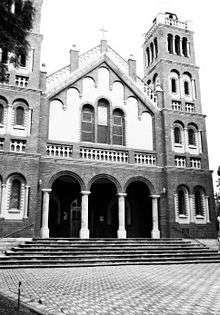
One of the earliest churches established in Polokwane (then Pietersburg) was the "English Church." Prior to 1894, there were occasional services for the English Church held by visiting priests in the local Court House. Work began on building a church in Market Street in 1895. The building was completed in 1897 and Christ Church had a permanent venue. The church struggled with a lack of members during the Anglo-Boer war (Boer Wars) but regular services resumed in November 1901 and have continued to this day. The Anglican church moved from Market Street to Biccard Street in the 1960s. There is also a Roman Catholic church situated in Biccard street.
Synagogues
The first Jewish settlers in Pietersburg arrived between 1890 and 1900 from Lithuania, Russia, and Latvia, and the Pietersburg Hebrew Congregation was founded in 1897. A synagogue was built on Jorissen Street in 1921. The Jewish community grew rapidly in the 1930s and 1940s; a larger synagogue was built in 1953 and the old synagogue was then converted into a communal hall. The number of Jews in Pietersburg began to decline from the late 1950s. In 2003, as the congregation had dwindled, the synagogue was closed and its benches, bimah, and other contents were shipped to Israel, where they were installed in the Mevasser Synagogue in Tel Mond in memory of the Pietersburg synagogue.[34]
Sports
Golf
The Pietersburg Golf Club along with the golf course was established in the late 1800s. The immaculate lush green course comprises a full 18 holes. Retief Goosen (born 3 February 1969) was born in Pietersburg and honed his skills at the Pietersburg Golf Club.
Cricket
The Polokwane Cricket Club is one of the oldest in the country and was established in 1902.[35]
Netball
The Limpopo Baobabs represents the city as well as the province of Limpopo in the Brutal Fruit Netball Cup. South African Spar Protea goal shooter Lenize Potgieter was also born in Polokwane.
Rugby
Noordelikes Rugby Club is the largest amateur rugby club based in the city.[36]
Starting in 2013, the city will host a Limpopo provincial team in the Vodacom Cup.[37]
Springbok rugby captain, Victor Matfield grew up in Polokwane. Former Springbok rugby captain John Smit was born in Polokwane.
Football
Winners Park F.C., Black Leopards F.C. and Polokwane City F.C., and Baroka F.C., South African football clubs, are based in the city.
Swimming
Polokwane has a number of swimming clubs. Former Olympic gold-medalist and world-record swimmer Lyndon Ferns is from the city.
Tennis
A large tennis club is situated in the city, and various local tournaments are held regularly.
Baseball
In 2017, Gift Ngoepe, born in then Pietersburg, became the first African player in the Major League Baseball, playing shortstop and second base for the Pittsburgh Pirates. Ngoepe's mother Maureen managed the baseball clubhouse in Randburg, near Johannesburg. Ngoepe's brother Victor also plays in the Pirates' farm system[38]
Stadiums
- Peter Mokaba Stadium, a newly constructed stadium for the 2010 FIFA World Cup[39]
- Pietersburg Stadium
Tourism
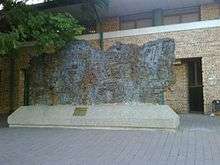
Polokwane provides access to various nature and wildlife viewing opportunities for ecotourists. The Polokwane Bird and Reptile Park is home to over 280 species of birds. The Polokwane Game Reserve houses various South African species of wildlife, birdlife, and plants in an unspoiled bushveld environment. The Moletzie Bird Sanctuary protects rare birds like the Cape vulture. The Modjadji Rainforest near Duiwelskloof holds the largest concentration of indigenous cycads in the world, and Cheune Crocodile Farm provides a place to learn about the life of crocodiles.[33]
An extensive art collection is preserved in Polokwane's art gallery, open to the public. The city has more public sculptures per capita in its parks than elsewhere in South Africa. Polokwane was also the first to unveil a bust of the ex-president Nelson Mandela in its City Square (Civic Gardens), and it was authorised by Nelson Mandela personally.[40]
The city is considered the premier hunting destination in South Africa.[41]
Commerce
The city hosts several major industries such as Coca-Cola[42], Freshmark (a division of Shoprite Checkers), and South African Breweries.[43] As the capital of the Limpopo province, the city also has a large commercial area with the four largest banks in the country all having at least three branches in the city. The city was well known for its manufacturing facility in Seshego of Tempest radios and hi-fis, the largest employer in the region.
Education
Tertiary education
The Tshwane University of Technology, and the University of South Africa both have satellite campuses in the city.[44][45] The University of Limpopo's Turfloop campus is situated about 30 km east of Polokwane.
Shopping malls
- Limpopo Mall
- Savannah Mall
- Cycad Center
- Seshego Circle
- Platinum Park
- Thornhill shopping center
- Mall of the North[46]
Notable people
- Lyndon Ferns, Olympic gold-medalist and former world record swimmer
- Retief Goosen, professional golfer who was in the top ten in the Official World Golf Ranking for over 250 weeks between 2001 and 2007
- Lucas Malan, Afrikaans academic and poet
- Julius Malema, leader of the Economic Freedom Fighters and former ANC Youth League president
- Isaac Lesiba Maphotho, anti-apartheid activist, African National Congress (ANC) member and Umkhonto we Sizwe (MK) veteran
- Victor Matfield, former South African national rugby team captain
- Peter Mokaba, controversial anti-apartheid activist
- Gift Ngoepe, professional baseball player
- Caster Semenya, middle-distance runner and world champion
- John Smit, former South African national rugby team captain
- Marthinus van Schalkwyk, former Minister of Tourism in the Cabinet of South Africa
- Frederik van Zyl Slabbert, political analyst, businessman and politician
Coats of arms
Municipal (1)
By 1931, the Pietersburg municipal council had assumed a pseudo-heraldic "coat of arms". The shield depicted a crossed pick and shovel, two crossed wheatsheaves, and the date 1904 surrounded by a rib and bearing the motto Labor omnia vincit. The crest was an ostrich.[47]
Municipal (2)
A proper coat of arms was designed in the 1960s. It was registered with the Transvaal Provincial Administration in August 1967[48] and at the Bureau of Heraldry in September 1969.[49]
The arms were : Azure, on a fess Argent, between in chief a lion passant Argent, armed and langued Gules, and in base two chevrons humette, and a horseshoe Argent, placed 2 and 1, two cogwheels Gules. In layman's terms, this was a blue shield displaying, from top to bottom, a silver lion with red tongue and claws, a silver stripe bearing two red cogwheels, and two silver chevrons and a horseshoe.
The crest was a golden eagle, and the motto, once again, was Labor omnia vincit.
Municipal (3)
The Polokwane municipal council registered a new coat of arms at the Bureau in October 2003.[49]
The arms are : Vert, on a fess Argent, a woven grain basket, between two hoes with blades turned inward proper, their handles towards centre-base counterchanged Or and issuant from a voided cogwheel the inner ring cotised Argent, therein a sun Or; on a chief of the last a short-clawed Lark (Mirafra chuana) perched upon a leaf of the silky thorn tree (Acacia rehmanniana) proper, between two demi-peaks with points embattled Brunatre, issuant from the respective shield flanks. In layman's terms, the shield depicts, from top to bottom, (1) a short-clawed lark perched on an acacia leaf between two stylised peaks, (2) a woven grain basket between two hoes on a silver background, and (3) a silver cogwheel on a green background.
Above the shield is a brown rustic crown. The motto is Unity - equity - prosperity.
References
- Polokwane | The Heart of the Limpopo Province Archived 2010-02-04 at the Wayback Machine
- "Main Place Polokwane". Census 2011.
- "Polokwane". Collins Dictionary. n.d. Retrieved 24 September 2014.
- "Polokwane | South Africa". Encyclopedia Britannica. Retrieved 2018-06-16.
- Polokwane - The Heart of the Limpopo Province. Archived 2010-02-04 at the Wayback Machine City of Polokwane official website. Retrieved on October 15, 2009.
- "Our history". Polokwane Local Municipality. Archived from the original on 2012-12-25. Retrieved 2009-09-19.
- "South Africa: Zuma comes out on top". The Economist. 19 December 2007.
- "The 52nd ANC National Conference - Polokwane 2007 | South African History Online". www.sahistory.org.za. Retrieved 2019-11-18.
- Chisholm, Hugh, ed. (1911). . Encyclopædia Britannica. 21 (11th ed.). Cambridge University Press. p. 592.
- "Seshego, Limpopo, South Africa". MBendi.
- "Polokwane". Stats SA.
- "Polokwane Property : All suburbs in Polokwane : Property24.com". m.property24.com. Retrieved 2018-06-16.
- "Our City - Our Townships and Suburbs". www.polokwane.gov.za. Archived from the original on 2018-06-17. Retrieved 2018-06-16.
- "Climate data for Polokwane". South African Weather Service. Archived from the original on March 4, 2012. Retrieved 7 March 2010.
- "Profiles: History of Polokwane". The African Executive. 12–19 December 2007. Archived from the original on 7 July 2011. Retrieved 10 February 2010.
- Peter Baxter. "Polokwane". WhyGo: South Africa. Archived from the original on 2010-04-12. Retrieved 10 February 2010.
- Average monthly and annual temperatures, Polokwane/Pietersburg 1932 – 2007, GISS
- GHCN monthly rainfall Pietersburg, NGDC, 1932-1992
- "Pietersburg Climate Normals 1961−1990". National Oceanic and Atmospheric Administration. Retrieved November 29, 2013.
- "Station Pietersburg (Polokwane)" (in French). Meteo Climat. Retrieved November 19, 2016.
- "FAPP - Polokwane Intl, ZA - Airport - Great Circle Mapper". Retrieved 10 February 2010.
- "Pietersburg Civil airport, Limpopo, South Africa". za.geoview.info. Retrieved 2018-06-16.
- "Freight rail given boost in Limpopo". Polokwane Observer. 24 February 2010. Archived from the original on 25 December 2011. Retrieved 8 October 2010.
- Sabc Corporate Archived 2009-09-18 at the Wayback Machine
- Jacaranda 94.2FM Archived 2012-03-30 at the National and University Library of Iceland
- CapricornFM Archived 2011-04-30 at the Wayback Machine
- "Energy FM". www.polokwanecity.co.za. Archived from the original on 2018-06-17. Retrieved 2018-06-16.
- "Munghana Lonene Fm , Polokwane | Zocal.co.za". zocal.co.za. Archived from the original on 2018-06-17. Retrieved 2018-06-16.
- "Bosveld Review". Review. Retrieved 2018-06-16.
- "Polokwane Observer". Polokwane Observer. Archived from the original on 2018-06-15. Retrieved 2018-06-16.
- https://www.suninternational.com/meropa/
- "Bakone Malapa Open-Air Museum". Planetware. Archived from the original on 7 December 2009. Retrieved 10 February 2010.
- "SA Places To See Polokwane". Zeuzzo 2010. Archived from the original on 14 April 2010. Retrieved 10 February 2010.
- The History of the Pietersburg (Polokwane) Jewish Congregation. JewishGen KehilaLinks. Retrieved on October 29, 2015.
- "Archived copy". Archived from the original on 2011-12-25. Retrieved 2010-12-04.CS1 maint: archived copy as title (link)
- http://www.polokwane.org.za/index.php?view_page+559%5B%5D
- "Limpopo set for Vodacom Cup". Sport 24. 16 January 2012.
- Tyler Kepner (8 May 2017). "First African to Play in the Major Leagues Is a 'Pinnacle' for Baseball". The New York Times. p. D1.
- "Peter Mokaba Stadium: the stadiums for the 2010 FIFA World Cup South Africa". FIFA. Archived from the original on 2010-05-28.
- "Archived copy". Archived from the original on 2018-01-22. Retrieved 2017-12-19.CS1 maint: archived copy as title (link)
- "I Heart Polokwane Because - South Africa Travel News". South Africa Travel. 2013-07-30. Retrieved 2018-06-16.
- "Home". Retrieved 2018-06-16.
- SAB Limited - Sites and locations Archived 2010-01-15 at the Wayback Machine
- About Us Archived 2010-04-29 at the Wayback Machine, Tshwane University of Technology
- UNISA
- "Mall of the North | Welcome to great shopping". www.mallofthenorth.co.za. Retrieved 2018-06-16.
- The arms were depicted on a cigarette card issued in 1931.
- Transvaal Official Gazette 3288 (30 August 1967).
- http://www.national.archsrch.gov.za%5B%5D
External links
- Official website
- Capricorn District Municipality website

.jpg)
.svg.png)